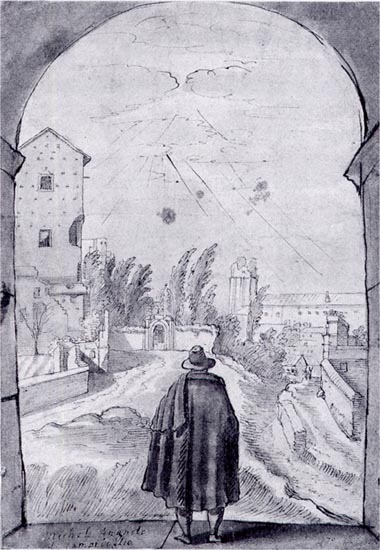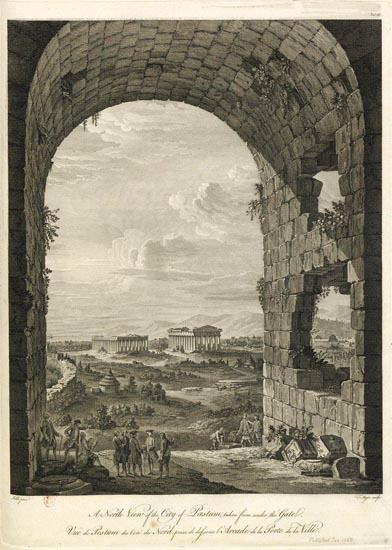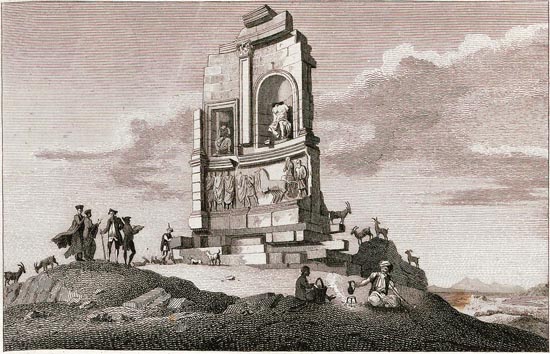MICHELE PACE DI CAMPIDOGLIO, The man who looks
Francisco Martínez Mindeguía
|
1. Michele Pace, Viaggiatore a Roma, con la torre delle Milizie al fondo. If to represent the objects as they were seen was a challenge in the Renaissance, in the 17th century the question was to understand what it is that we see really. At the beginning of the century René Descartes and Galileo Galilei made an effort to see the things as they really were and not as they seemed to be, to separate the true from the false (O'Toole, 1999, pp.1-7). But almost at the same time the monks of Trinita dei Monti, Rome, were experimenting with anamorphic perspectives, Francesco Borromini built the galleria prospettica of the Palazzo Spada (1652-1653) and Andrea Pozzo 'lifted' the false dome of Sant'Ignazio (1685) and 'did fade' the vault of the same church (1691-1694). To do see what is not could be a virtue or a sharpness of the wit, and the fiction could be a way to reach to what was true (Assunto 1979, p.104). In the late eighteenth, 'knowing how to see' was became a study and debate object, was theorized about the language of the vision and about the way of seeing. The present article intends to revise some aspects of this evolution, from four drawings that share a similar composition but differ in the meaning. 1. MICHELE PACE DI CAMPIDOGLIO The first one is a drawing of Michele Pace, more known as Michelangelo di Campidoglio, because of the place where he had his workshop (Fig. 1)1. It's titled Viaggiatore a Roma, con la torre delle Milizie al fondo, and it shows a man from his back, who looks at the city. We do not see his face, nor which is his attitude, only that he observes, immobile. The city is Rome but the central subject of the drawing is this character defined with greater clarity and in contrast with the background that vanishes with the distance. The arch, under which he remain, acts as the frame of a proscenium that, when indicating the limit of the scene, includes also to us, as spectators. In this arrangement, the draftsman, sees what the character sees, almost with the same point of view, and does that also we see it, sharing his experience. In order to understand better this observer it is convenient to go to El Criticón, of Baltasar Gracián, who tells the experiences of two characters who observe the world and judge what they see. Almost at the beginning of the work, one of them says:
With this image Gracián indicates the importance of that something have to draw attention of the one who observes and make him see the things as if they were new. In the drawing, the character, maybe the own Michele Pace, is a newcomer to the city that sees it as if he had never seen it and admired discovers its prodigies. Later on, Gracián insists on this aspect:
2. THOMAS MAJOR The second drawing is an engraving that Thomas Major3 published in The Ruins of Paestum otherwise Posidonia, in 1768 (Fig. 2). |
|
2. Thomas Major, A North view of the city of Paestum, 1768. It was not the result of an expedition, since Major was never in Paestum and the engravings derive from other previous works, in this case, of an oil of Antonio Joli, of 1738, which Major used without introducing changes. His framing relates it to Pace's drawing and corresponds to a view of the city from the north door of the city wall, with the three temples at the bottom. Under the arch, a group of characters converses without paying attention to them; to the left, one of the characters draws the arch following the instructions of other two and, to the right, three soldiers accompany to the retinue. Compared with that of Pace, here there is no 'admiration', in spite of being newcomers and being warned, replaced with a scientific and erudite distancing. Instead, what it suggests is the contrast of the fugacity of the presence of the travellers, in front of the permanence of the archaeological remains. To understand the composition it would be necessary go back to 1711, when Joseph Addison starts publishing in London The Spectator, a diary of a single page in which he describes himself as a spectator who observes what happens around it4. In the first number he was said: 'I live in the World, rather as a Spectator of Mankind, than as one of the Species' (Addison 1711, n.1). And at number 10, eleven days later:
The elitist distancing of Addison and his lack of empathy with what he observes was shared, in certain way, in some of the English expeditions that, from 1749, travelled to the continent in search of the Roman and Greek antiquity, and that published its results later. All these expeditions have provided an admirable graphical material but, observed in detail, it can seem that the most important of the expedition was the own expedition: be there and to look at what few ones could tell have seen, the pieces of a museum that was not possible to transport. The social repercussion of the expedition is what seems to justify that some of its authors were represented themselves in the engravings of those ruins. It happened this way in the third book of The Antiquities of Athens, of James Stuart and Nicholas Revett, where they appear in front of the monument of Philopappus (Fig. 3). |
|
3. James Stuart, The monument of Philopappus, 1762 (vol. 3, cap. V, lam.29, parte superior). They appear conversing with James Dawkins and Robert Wood (protagonists of the expeditions to Palmyra and Balbec), with those they seem to have coincided returning these to England. It has to indicate that, in the image, while Dawings and Woods are dressed at the English style, Stuart and Rewet are dressed to the Turkish, to add theatricality to the representation. In the commentary of the plate, Stuart says:
The anecdote of the trip is mixed without justification with the scientific description of the monument, dramatizing the archaeological experience, possibly to bring it near to a public not as erudite as it could seem. The anecdotal situations are repeated in other engravings, with characters of which Stuart gives the names and the story that justifies their presence. An example, it is the commentary of the plate XIX, of the second book, of the Temple of Minerva Polias and of the Pandrosium (Fig. 4): |
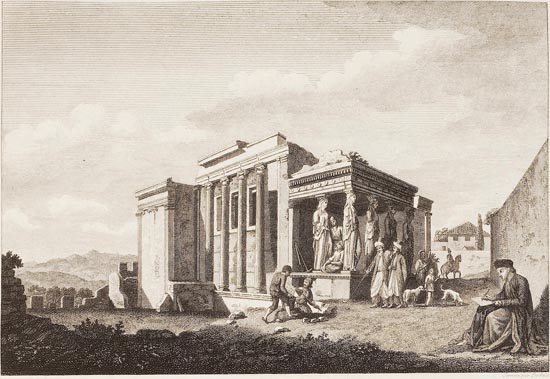 |
4. James Stuart, Temple of Minerva Polias and of the Pandrosium, 1762 .
This is the World as a Theatre to which Addison was referred and that impregnated the aesthetic studies of architecture, filling them with theatrical terms as 'scene', 'stage', 'staging', 'scenery' or 'representation'. 3. VIOLLET-LE-DUC The third drawing is a watercolour of Viollet-le-Duc, of the interior of Sant'Agnese fuori le Mura, of Rome (Fig. 5). |
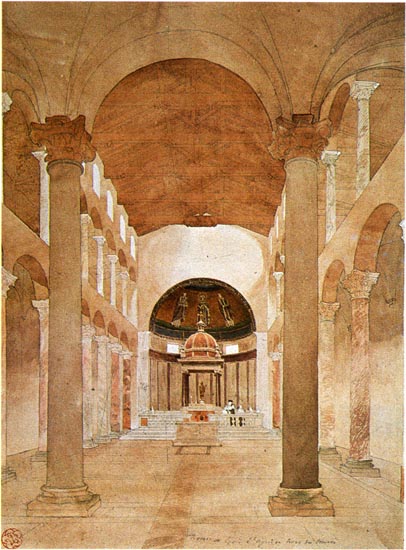 |
5. Viollet-le-Duc, Santa Agnese fuori le Mura, of Rome, 1836. It is of 1836, of his first trip to Italy, and shows the interior of the central nave of the church from the narthex of the entry, with a framing similar to the previous ones. Here the interest is focused at the bottom of the nave, in the ciborium of the altar and the apse. The rest, much less detailed, just seems to be the necessary frame of these elementss. To understand better the image it is convenient compare it with the one that Paul-Marie Letarouilly drew not after 1832 (Fig. 6). |
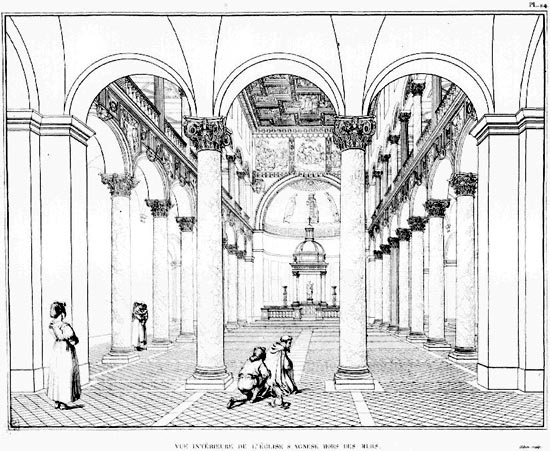 |
6. Paul-Marie Letarouilly, Sant'Agnese fuori le Mura, of Rome, 1840. It can be seen that Viollet-le-Duc has eliminated the coffered ceiling, which was built in 1606, and also the decoration of the walls of the nave: he has simplified the image reducing it to what strictly corresponds to the church of the 8th century. Self-taught, independent in his acts and in his ideas, a rebel according to some, Viollet-le-Duc sees a reality that is not the apparent one, or not the one that others see. He analyses, differentiates the original state and the additions, values its effect and finally he shows the space as he thinks that it should be. He has issued a judgment and this one is the result. Viollet-le-Duc believed that 'architecture has to do mainly with the faculty of reasoning', a principle that he recommended to apply in the training of the architect:
The self-referential value that had the character of the drawing of Pace, it is assumed here by the transformation that Viollet-le-Duc applies on what he sees. 4. LE CORBUSIER The fourth drawing is of Le Corbusier (Fig. 7), published in La maison des Hommes (p.99.), in 1942, without title. |
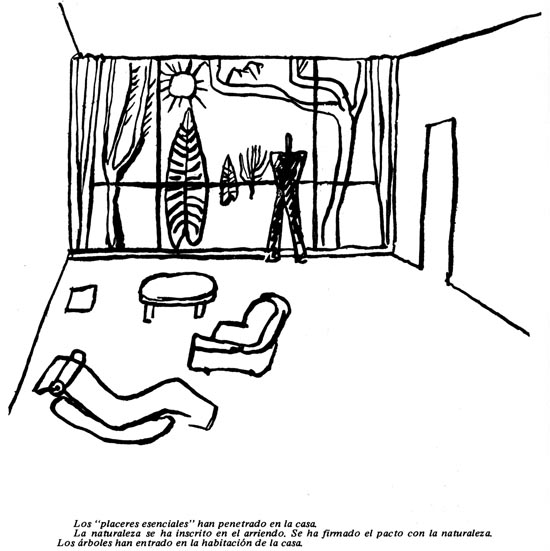 |
7. Le Corbusier, La maison des Hommes, 1942. As in the drawing of Michele Pace, a man of backs contemplates the landscape, but here he is inside a house, in front of a window. As in that case, the character places himself faces to the spectacle of nature, as if the window frame were the proscenium arch of a theatre or the screen of a cinema. Here Le Corbusier himself is who clarifies the meaning of the drawing, in the text that he includes in the foot: It is understood that the 'essential pleasures' (the Sun, the space and the vegetation) 'enter' because we can see them. The ambiguity of the text is solved in another previous drawing of the same book (Fig. 8). |
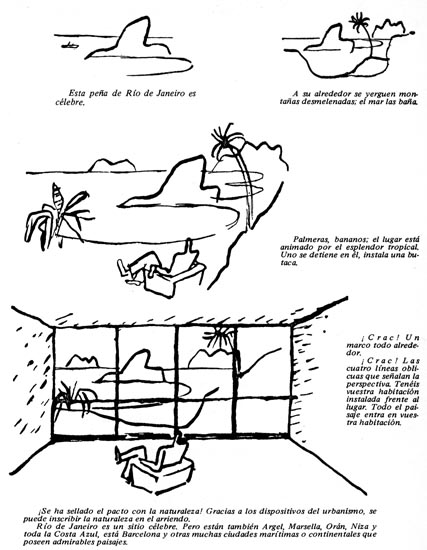 |
8. Le Corbusier, La maison des Hommes, 1942. It is a similar composition, which Corbusier builds with a sequence characteristic of a comic, and that he concludes in the inferior 'panel'. The text to its right and under it says the following:
Also this character has noticed the importance of what he sees, but seems to react in a differently from Pace: he sits and enjoys seeing it. He tell us that it is not necessary 'to go out' to meet it, because the landscape is what we see: it is a 'mental construction' that every observer elaborates from 'what one sees', on having contemplated a territory or a country (Maderuelo 2010, p.575). The landscape 'is presented to our perception and fantasy as an aesthetic object' (Milani 2001, p.115) or, as Michel Corajoud (2010) says in the title of one of his books, 'the landscape is the place where the sky and the earth touch each other'. Le Corbusier has solved the problem of Pace turning it into a discovery. FINAL Goethe told that 'we theorize in every attentive look directed to the world' (1810, p.58). That look is active, it contains a question and what finally we see depends on it. It is the discovery of Le Corbusier, the reasoning of Viollet-le-Duc, the indifference of the antiquity of the engraving of Major and the emotion in the drawing of Michele Pacee. Raffaele Milani says that 'every look creates an 'ideal landscape' within us', what, in certain way, sends to Thomas Browne (1643, sec XI), that said that the world that we see we are we ourselves, reflected in all that we look. Possibly because of it, to obtain the necessary distancing and to prevent this image confuses us, it is necessary to observe the landscape in silence (Turri 2004, p.11). |
Notes:
1 - Bösel and Frommel, 2000, v.2, p.77.
- Assunto, R., 1979. Infinita contemplazione… Naples: Società Editrice Napolitana.
© of Francisco Martínez Mindeguía’s texts This article has been published by the same author in EGA expresión gráfica arquitectónica, 29, Valencia 2017, pp. 180-189. |
>> Back to the top of the page
>> Back to Dibujos Ejemplares de Arquitectura
